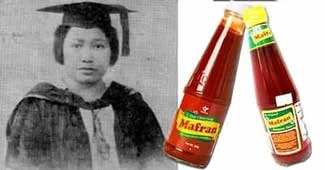Maria Orosa: the Taal-Born Scientist credited with the Invention of the Banana Ketchup
Back in the sixties when I was a small boy growing up inside Fernando Air Base in Lipa City, the only brand of ketchup my mother ever brought inside the household was Del Monte tomato ketchup. The Philippine Peso to US Dollar exchange rate was less than 4 to 11. The goods sold at the PX inside the base (short for Post Exchange, a military retail store) were tax free. American brand ketchup was inexpensive.
Then came the Middle East oil crisis and suddenly the peso exchange rate went spiraling out of control. Prices of basic commodities went skyrocketing and my mother’s Batangueño aremuhunan (a philosophy of frugality) methods kicked into motion. Out went the imported Carnation canned milk and in came locally manufacture brands. Out went the Del Monte tomato ketchup and in came… this strange new Mafran banana ketchup.
These days, the banana ketchup is likely ubiquitous in Filipino households. Now here is something that ought to be of interest to Batangueño readers: credit for the invention of the banana ketchup is generally given to one of our own, a food technologist and pharmaceutical chemist from Taal by the name of Maria Ylagan Orosa2.
She was born on 29 November 1893, the fifth child of Simplicio Orosa and the former Juliana Ylagan3. In 1915, she studied at the University of the Philippines’ College of Pharmacy. A year later, she left the country to study at the University of Seattle as a government scholar. There, she first earned a Bachelor of Science in Pharmaceutical Chemistry in 1917, following this up one year later with a degree in Food Chemistry.
In 1920, she obtained a degree in Pharmacy and followed this up one year later with a master’s degree in the same field. Returning to the Philippines in 1922, she initially taught Home Economics at the Centro Escolar University. The following year, she would transfer to the Bureau of Science to work as a chemist and later organize the bureau’s food preservation division.
In 1928, the government sent her abroad to study food processing and canning technology in several countries. By 1933, she was appointed head of the bureau’s Food Preservation Division. In 1941, she founded the Homemakers’ Association of the Philippines.
By late 1942, the war in the Pacific had reached the shores of the Philippines, and Orosa joined a guerrilla group called the Marking’s Guerrillas. She was given the rank of captain. Her best work with the guerrilla group was in feeding Allied prisoners of war in Japanese concentration camps with a high protein concoction she had developed called Soyalac, made basically from soya milk.
But back to the banana ketchup, although I did not get to sample this until the late sixties or the early seventies, in fact, it was first developed in 1942. Its invention was credited to Orosa, and its creation was largely because of a tomato shortage brought on by the onset of World War II.
This type of ketchup was first mass produced for commercial consumption by a company founded by Magdalo V. Francisco, from whose name the brand Mafran was created. Jufran, another famous banana ketchup brand, was taken from the nickname of Francisco’s son, Magdalo Jr. or “Jun.4”
The banana ketchup and the Soyalac were by no means Orosa’s only legacies. She was also responsible for the development of calamansi (calamondin, a Philippine lime) juice. She created processes for the creation of Filipino wines from native fruits like cashew and guava. She also found a way to create vinegar from pineapple and jelly from guava, cottonfruit (santol), mango and other fruits.
Her creativeness and drive to process local products knew no bounds. She developed banana starch and flour from banana and cassava. She also invented rice cookies, supposed to be an effective treatment for patients suffering with beri-beri, an ailment caused by thiamine deficiency5.
Orosa was just 52 years old when she was hit by shrapnel in 1945 during the liberation of Manila by Allied Forces. Typical of her, she was performing her duties at the Bureau of Plant Industries building when a bomb exploded close by. Colleagues were still able to rush her to a nearby hospital, but unfortunately the hospital itself was bombed while she was being treated. Another shrapnel hit her directly in the heart, causing instantaneous death.
God only knows what other things she could have created had she not passed on at such a relatively young age. It goes without saying, however, that the legacy she left behind would have taken ordinary people several lifetimes to achieve.
2 “Maria Orosa,” Wikipedia.
3 Along with many details of this article, from “Maria Y. Orosa, 1893-1945,” online at Cite Seer X.
4 “Banana Ketchup,” Wikipedia.
5 “What is beriberi?” online at Healthline.

